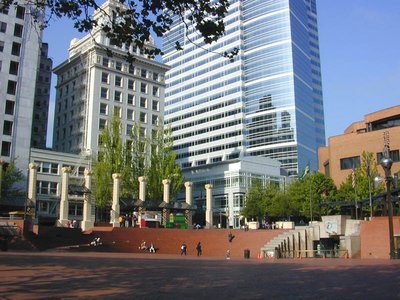Now that the easy-money housing boom has fizzled, it is tricky to predict what will happen next with commercial real estate in Oregon.
STATEWIDE Now that the easy-money housing boom has fizzled, it is tricky to predict what will happen next with commercial real estate in Oregon.
Banks have tightened lending, and investors are watching warily to see whether rumors of recession build into full-blown realities of lost jobs and dwindling consumer confidence.
Still, vacancy rates are holding steady in most of Oregon’s urban centers, construction employment hit an all-time high last summer, rents generally are up and ambitious projects are breaking ground all over the state, even in Bend — Oregon’s capital of boom followed by bust — where builders are cranking out new stores, offices and corporate headquarters for Les Schwab Tire Centers.
How long can it last?
An extensive national report issued last November by PricewaterhouseCoopers and the Land Institute warned of a serious drop-off in commercial real estate investments and cited major concerns from the 600 developers, service firms and investors surveyed. That same report, however, mentioned Portland as one of a handful of bright spots for investors to consider. And two more recent reports, one by Grubb & Ellis and the other by Norris, Beggs & Simpson, argue that Portland’s commercial market appears solid. Central city office vacancy rates have held steady at around 10%, while industrial properties have reached 20-year lows in vacancy and record highs in rent. Condos are cold, but apartment buildings are hot.
“The fevered pitch of bidding on properties has gone down, but there is still a lot of capital available,” says Patricia Raicht, client services manager for Grubb & Ellis. “There is no lack of investors interested in commercial real estate.”
Nor is there a lack of construction. Bart Eberwein, vice president of Portland-based Hoffman Construction Company, can easily reel off a half-dozen multi-million-dollar projects his firm is completing, such as OHSU’s $70 million Biomedical Research Building. “Health care continues to be a big market for us,” he says, “and I don’t see that changing.”
One thing that has changed is the level of scrutiny from lenders. “Everyone is being more cautious about new deals and how we underwrite them,” says Roberta Fuhr, senior vice president for KeyBank Real Estate Capital, the largest commercial lender in Oregon. That gives the edge to existing clients and investors with cash, while sending highly leveraged newcomers to the back of the line.
Most economists accept more stringent loan requirements as a healthy part of the ongoing correction of a money-lending system that had slid out of control. They don’t expect it to bring down the commercial market, so long as tighter credit doesn’t devolve into a lack of credit — and a recession remains just theoretical.
BEN JACKLET
Have an opinion? E-mail [email protected]


